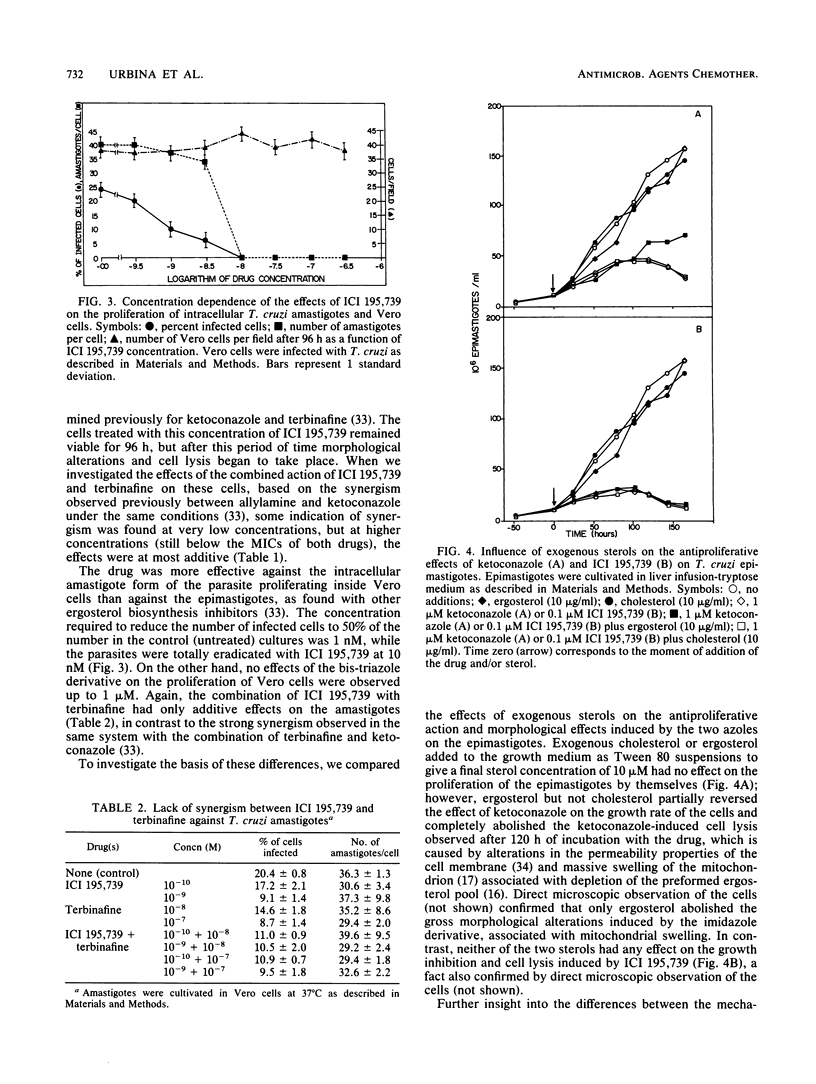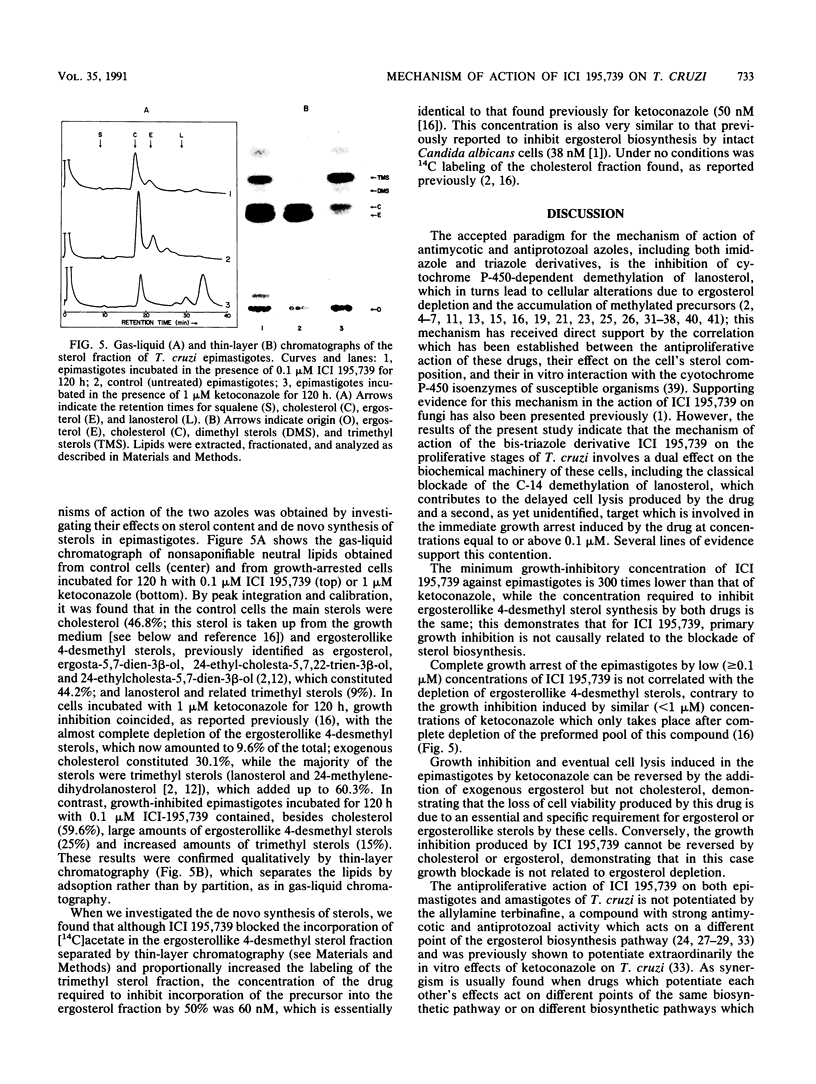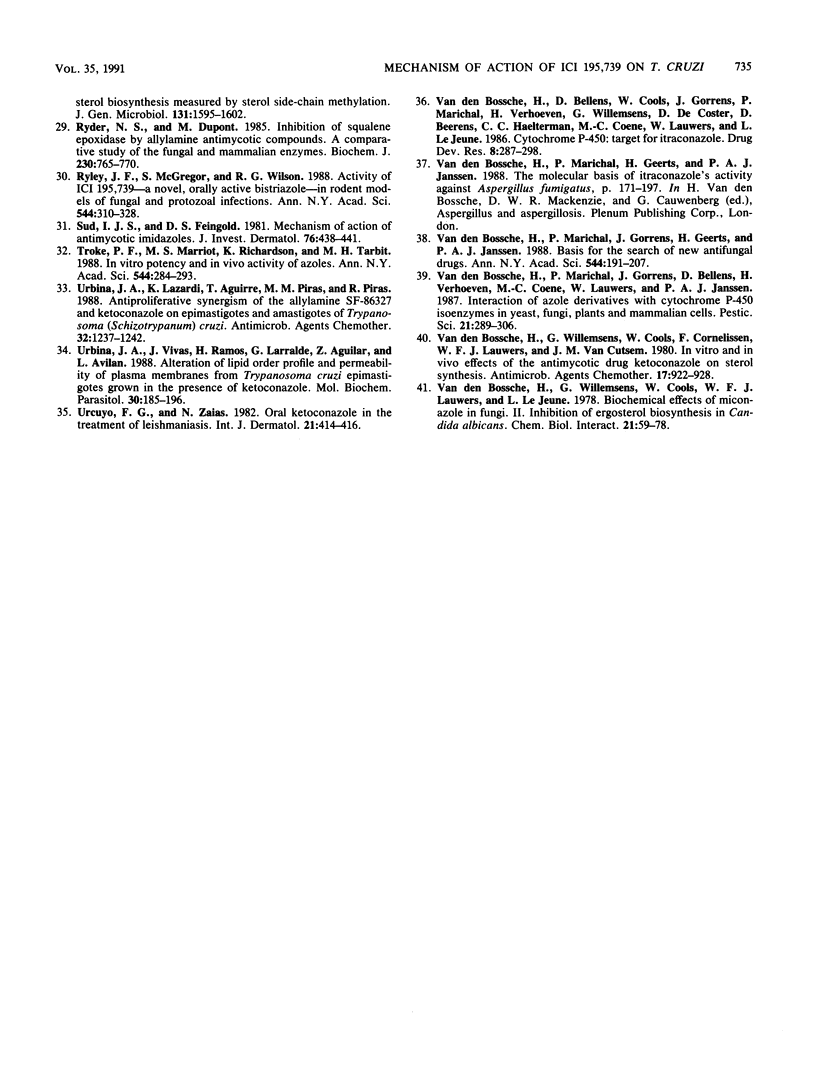Abstract
The in vitro antiproliferative effects of ICI 195,739, a recently developed bis-triazole derivative (T. Boyle, D. J. Gilman, M. B. Gravestock, and J. M. Wardleworth, Ann. N.Y. Acad. Sci. 544:86-100, 1988; J. F. Ryley, S. McGregor, and R. G. Wilson, Ann. N.Y. Acad. Sci. 544:310-328, 1988), on epimastigotes and amastigotes of Trypanosoma (Schizotrypanum) cruzi and some aspects of its mechanism of action are described. Despite previous claims that triazole compounds act on susceptible organisms by essentially the same mechanism demonstrated for the imidazole compounds, i.e., by interfering with the synthesis of ergosterol at the level of the cytochrome P-450-dependent C-14 demethylation of lanosterol, our results indicate that ICI 195,739 acts on T. cruzi epimastigotes by a dual mechanism which involves blockade of ergosterol byosynthesis and a second, still-unidentified target whose alteration leads to immediate growth arrest. Although ICI 195,739 blocks ergosterol biosynthesis at the level of C-14 lanosterol demethylation, as shown by gas-liquid and thin-layer chromatography, growth arrest in ICI 195,739-treated cells is not related to the depletion of the endogenous ergosterol pool, contrary to what was previously found for ketoconazole, the reference compound among antifungal and antiprotozoal azole derivatives. Consistent with this observation is the fact that the concentration of ICI 195,739 required to inhibit de novo synthesis of ergosterol in epimastigotes by 50% is 60 nM, which is essentially identical to that previously found for ketoconazole under identical conditions, while the minimum concentration required to produce complete growth inhibition is 0.1 microM, which is 300 times lower than that of ketoconazole. With respect to the intracellular amastigote form proliferating inside vertebrate (Vero) cells, 10 nM is sufficient to eradicate the parasite completely in 96 h, with no effects on the host cells; this concentration is identical to that previously found for ketoconazole. Growth inhibition and morphological alterations induced by ketoconazole can be reserved by exogenously added ergosterol but not by cholesterol; for ICI 195, 739, neither sterol is capable of reserving the drug effects. Contrary to what was observed for ketoconazole, the in vitro antiproliferative effects of ICI 195, 739 on both forms of the parasite are not potentiated by the simultaneous presence of terbinafine, an allylamine which blocks ergosterol production by the parasite at a different level of the sterol biosynthetic pathway. These results, together with those of an accompanying study of the ultrastructural alterations induced by the drug, strongly support the notion that ICI 195, 739 acts on T. cruzi by a novel combination of biochemical and cellular effects, which could explain its extraordinary potency in vivo against the parasite.
Full text
PDF





Images in this article
Selected References
These references are in PubMed. This may not be the complete list of references from this article.
- Barrett-Bee K., Lees J., Pinder P., Campbell J., Newboult L. Biochemical studies with a novel antifungal agent, ICI 195,739. Ann N Y Acad Sci. 1988;544:231–244. doi: 10.1111/j.1749-6632.1988.tb40409.x. [DOI] [PubMed] [Google Scholar]
- Beach D. H., Goad L. J., Holz G. G., Jr Effects of antimycotic azoles on growth and sterol biosynthesis of Leishmania promastigotes. Mol Biochem Parasitol. 1988 Nov;31(2):149–162. doi: 10.1016/0166-6851(88)90166-1. [DOI] [PubMed] [Google Scholar]
- Beach D. H., Goad L. J., Holz G. G., Jr Effects of ketoconazole on sterol biosynthesis by Trypanosoma cruzi epimastigotes. Biochem Biophys Res Commun. 1986 May 14;136(3):851–856. doi: 10.1016/0006-291x(86)90410-9. [DOI] [PubMed] [Google Scholar]
- Berman J. D. Activity of imidazoles against Leishmania tropica in human macrophage cultures. Am J Trop Med Hyg. 1981 May;30(3):566–569. doi: 10.4269/ajtmh.1981.30.566. [DOI] [PubMed] [Google Scholar]
- Berman J. D., Goad L. J., Beach D. H., Holz G. G., Jr Effects of ketoconazole on sterol biosynthesis by Leishmania mexicana mexicana amastigotes in murine macrophage tumor cells. Mol Biochem Parasitol. 1986 Jul;20(1):85–92. doi: 10.1016/0166-6851(86)90145-3. [DOI] [PubMed] [Google Scholar]
- Berman J. D., Holz G. G., Jr, Beach D. H. Effects of ketoconazole on growth and sterol biosynthesis of Leishmania mexicana promastigotes in culture. Mol Biochem Parasitol. 1984 May;12(1):1–13. doi: 10.1016/0166-6851(84)90039-2. [DOI] [PubMed] [Google Scholar]
- Bloch K. E. Sterol structure and membrane function. CRC Crit Rev Biochem. 1983;14(1):47–92. doi: 10.3109/10409238309102790. [DOI] [PubMed] [Google Scholar]
- Borelli D. A clinical trial of itraconazole in the treatment of deep mycoses and leishmaniasis. Rev Infect Dis. 1987 Jan-Feb;9 (Suppl 1):S57–S63. doi: 10.1093/clinids/9.supplement_1.s57. [DOI] [PubMed] [Google Scholar]
- Boyle F. T., Gilman D. J., Gravestock M. B., Wardleworth J. M. Synthesis and structure-activity relationships of a novel antifungal agent, ICI 195,739. Ann N Y Acad Sci. 1988;544:86–100. doi: 10.1111/j.1749-6632.1988.tb40391.x. [DOI] [PubMed] [Google Scholar]
- Docampo R., Moreno S. N., Turrens J. F., Katzin A. M., Gonzalez-Cappa S. M., Stoppani A. O. Biochemical and ultrastructural alterations produced by miconazole and econazole in Trypanosoma cruzi. Mol Biochem Parasitol. 1981 Jul;3(3):169–180. doi: 10.1016/0166-6851(81)90047-5. [DOI] [PubMed] [Google Scholar]
- Goad L. J., Berens R. L., Marr J. J., Beach D. H., Holz G. G., Jr The activity of ketoconazole and other azoles against Trypanosoma cruzi: biochemistry and chemotherapeutic action in vitro. Mol Biochem Parasitol. 1989 Jan 15;32(2-3):179–189. doi: 10.1016/0166-6851(89)90069-8. [DOI] [PubMed] [Google Scholar]
- Goad L. J., Holz G. G., Jr, Beach D. H. Sterols of ketoconazole-inhibited Leishmania mexicana mexicana promastigotes. Mol Biochem Parasitol. 1985 Jun;15(3):257–279. doi: 10.1016/0166-6851(85)90089-1. [DOI] [PubMed] [Google Scholar]
- Hart D. T., Lauwers W. J., Willemsens G., Vanden Bossche H., Opperdoes F. R. Perturbation of sterol biosynthesis by itraconazole and ketoconazole in Leishmania mexicana mexicana infected macrophages. Mol Biochem Parasitol. 1989 Mar 1;33(2):123–134. doi: 10.1016/0166-6851(89)90026-1. [DOI] [PubMed] [Google Scholar]
- Heeres J., Backx L. J., Mostmans J. H., Van Cutsem J. Antimycotic imidazoles. part 4. Synthesis and antifungal activity of ketoconazole, a new potent orally active broad-spectrum antifungal agent. J Med Chem. 1979 Aug;22(8):1003–1005. doi: 10.1021/jm00194a023. [DOI] [PubMed] [Google Scholar]
- Larralde G., Vivas J., Urbina J. A. Concentration and time dependence of the effects of ketoconazole on growth and sterol synthesis by Trypanosoma (Schizotrypanum) cruzi epimastigotes. Acta Cient Venez. 1988;39(2):140–146. [PubMed] [Google Scholar]
- Lazardi K., Urbina J. A., de Souza W. Ultrastructural alterations induced by ICI 195,739, a bis-triazole derivative with strong antiproliferative action against Trypanosoma (Schizotrypanum) cruzi. Antimicrob Agents Chemother. 1991 Apr;35(4):736–740. doi: 10.1128/aac.35.4.736. [DOI] [PMC free article] [PubMed] [Google Scholar]
- Lazardi K., Urbina J. A., de Souza W. Ultrastructural alterations induced by two ergosterol biosynthesis inhibitors, ketoconazole and terbinafine, on epimastigotes and amastigotes of Trypanosoma (Schizotrypanum) cruzi. Antimicrob Agents Chemother. 1990 Nov;34(11):2097–2105. doi: 10.1128/aac.34.11.2097. [DOI] [PMC free article] [PubMed] [Google Scholar]
- McCabe R. E., Remington J. S., Araujo F. G. In vitro and in vivo effects of itraconazole against Trypanosoma cruzi. Am J Trop Med Hyg. 1986 Mar;35(2):280–284. doi: 10.4269/ajtmh.1986.35.280. [DOI] [PubMed] [Google Scholar]
- McCabe R. E., Remington J. S., Araujo F. G. Ketoconazole inhibition of intracellular multiplication of Trypanosoma cruzi and protection of mice against lethal infection with the organism. J Infect Dis. 1984 Oct;150(4):594–601. doi: 10.1093/infdis/150.4.594. [DOI] [PubMed] [Google Scholar]
- McCabe R. E., Remington J. S., Araujo F. G. Ketoconazole promotes parasitological cure of mice infected with Trypanosoma cruzi. Trans R Soc Trop Med Hyg. 1987;81(4):613–615. doi: 10.1016/0035-9203(87)90430-5. [DOI] [PubMed] [Google Scholar]
- Nes W. R., Dhanuka I. C., Pinto W. J. Evidence for facilitated transport in the absorption of sterols by Saccharomyces cerevisiae. Lipids. 1986 Jan;21(1):102–106. doi: 10.1007/BF02534311. [DOI] [PubMed] [Google Scholar]
- Nes W. R., Sekula B. C., Nes W. D., Adler J. H. The functional importance of structural features of ergosterol in yeast. J Biol Chem. 1978 Sep 10;253(17):6218–6225. [PubMed] [Google Scholar]
- Petranyi G., Ryder N. S., Stütz A. Allylamine derivatives: new class of synthetic antifungal agents inhibiting fungal squalene epoxidase. Science. 1984 Jun 15;224(4654):1239–1241. doi: 10.1126/science.6547247. [DOI] [PubMed] [Google Scholar]
- Raether W., Seidenath H. Ketoconazole and other potent antimycotic azoles exhibit pronounced activity against Trypanosoma cruzi, Plasmodium berghei and Entamoeba histolytica in vivo. Z Parasitenkd. 1984;70(1):135–138. doi: 10.1007/BF00929583. [DOI] [PubMed] [Google Scholar]
- Richardson K., Cooper K., Marriott M. S., Tarbit M. H., Troke P. F., Whittle P. J. Design and evaluation of a systemically active agent, fluconazole. Ann N Y Acad Sci. 1988;544:4–11. doi: 10.1111/j.1749-6632.1988.tb40385.x. [DOI] [PubMed] [Google Scholar]
- Ryder N. S., Dupont M. C. Inhibition of squalene epoxidase by allylamine antimycotic compounds. A comparative study of the fungal and mammalian enzymes. Biochem J. 1985 Sep 15;230(3):765–770. doi: 10.1042/bj2300765. [DOI] [PMC free article] [PubMed] [Google Scholar]
- Ryder N. S. Effect of allylamine antimycotic agents on fungal sterol biosynthesis measured by sterol side-chain methylation. J Gen Microbiol. 1985 Jul;131(7):1595–1602. doi: 10.1099/00221287-131-7-1595. [DOI] [PubMed] [Google Scholar]
- Ryder N. S. Specific inhibition of fungal sterol biosynthesis by SF 86-327, a new allylamine antimycotic agent. Antimicrob Agents Chemother. 1985 Feb;27(2):252–256. doi: 10.1128/aac.27.2.252. [DOI] [PMC free article] [PubMed] [Google Scholar]
- Ryley J. F., McGregor S., Wilson R. G. Activity of ICI 195,739--a novel, orally active bistriazole--in rodent models of fungal and protozoal infections. Ann N Y Acad Sci. 1988;544:310–328. doi: 10.1111/j.1749-6632.1988.tb40416.x. [DOI] [PubMed] [Google Scholar]
- Sud I. J., Feingold D. S. Mechanisms of action of the antimycotic imidazoles. J Invest Dermatol. 1981 Jun;76(6):438–441. doi: 10.1111/1523-1747.ep12521036. [DOI] [PubMed] [Google Scholar]
- Troke P. F., Marriott M. S., Richardson K., Tarbit M. H. In vitro potency and in vivo activity of azoles. Ann N Y Acad Sci. 1988;544:284–293. doi: 10.1111/j.1749-6632.1988.tb40414.x. [DOI] [PubMed] [Google Scholar]
- Urbina J. A., Lazardi K., Aguirre T., Piras M. M., Piras R. Antiproliferative synergism of the allylamine SF 86-327 and ketoconazole on epimastigotes and amastigotes of Trypanosoma (Schizotrypanum) cruzi. Antimicrob Agents Chemother. 1988 Aug;32(8):1237–1242. doi: 10.1128/aac.32.8.1237. [DOI] [PMC free article] [PubMed] [Google Scholar]
- Urbina J. A., Vivas J., Ramos H., Larralde G., Aguilar Z., Avilán L. Alteration of lipid order profile and permeability of plasma membranes from Trypanosoma cruzi epimastigotes grown in the presence of ketoconazole. Mol Biochem Parasitol. 1988 Aug;30(2):185–195. doi: 10.1016/0166-6851(88)90111-9. [DOI] [PubMed] [Google Scholar]
- Urcuyo F. G., Zaias N. Oral ketoconazole in the treatment of leishmaniasis. Int J Dermatol. 1982 Sep;21(7):414–416. doi: 10.1111/j.1365-4362.1982.tb03163.x. [DOI] [PubMed] [Google Scholar]
- Van den Bossche H., Willemsens G., Cools W., Cornelissen F., Lauwers W. F., van Cutsem J. M. In vitro and in vivo effects of the antimycotic drug ketoconazole on sterol synthesis. Antimicrob Agents Chemother. 1980 Jun;17(6):922–928. doi: 10.1128/aac.17.6.922. [DOI] [PMC free article] [PubMed] [Google Scholar]
- Vanden Bossche H., Marichal P., Gorrens J., Geerts H., Janssen P. A. Mode of action studies. Basis for the search of new antifungal drugs. Ann N Y Acad Sci. 1988;544:191–207. doi: 10.1111/j.1749-6632.1988.tb40404.x. [DOI] [PubMed] [Google Scholar]
- de Maio A., Urbina J. A. Trypanosoma (Schizotrypanum) cruzi: terminal oxidases in exponential and stationary growth phase emipastigotes cultured in vitro. Acta Cient Venez. 1984;35(2):136–141. [PubMed] [Google Scholar]
- van den Bossche H., Willemsens G., Cools W., Lauwers W. F., Le Jeune L. Biochemical effects of miconazole on fungi. II. Inhibition of ergosterol biosynthesis in Candida albicans. Chem Biol Interact. 1978 Apr;21(1):59–78. doi: 10.1016/0009-2797(78)90068-6. [DOI] [PubMed] [Google Scholar]



